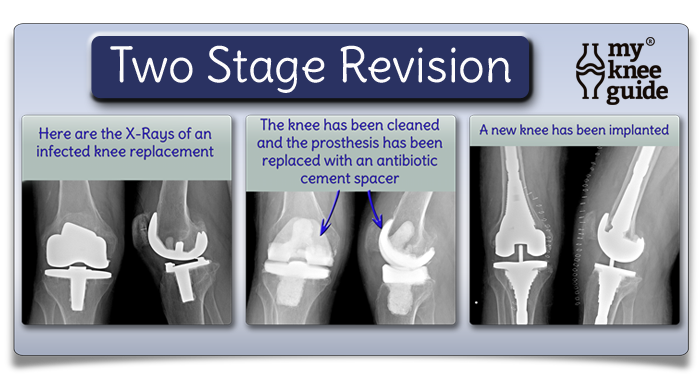Normal symptoms after hip or knee replacement include a slight redness and warmth around the joint as well as bruising or ecchymosis. At the University of Utah Center for Hip and Knee Reconstruction we use a waterproof occlusive dressing that is impregnated with silver ions.
 Infection An Uncommon But Serious Complication
Infection An Uncommon But Serious Complication
Seek care immediately if you are also experiencing.
.jpg)
Signs of infection in knee replacement. A relatively small number of patients - about one in 100 - may develop an infection after joint replacement. However bacteria are everywhere and an open wound is susceptible to infection read my article about going to the dentist after knee replacement. A small percentage of patients undergoing hip or knee replacement roughly about 1 in 100 may develop an infection after the operation.
Skin around the incision after a knee replacement can become red irritated or inflamed if infected. Infections are caused by viruses or bacteria. Other symptoms may include.
The most serious infections occur inside the knee joint where the bodys immune system has a difficult time fighting the infection. Inability to move your knee due to pain or stiffness. The incision may become swollen along the skin edges or around the staples and have a red or flushed appearance.
Knee replacement is a common procedure most often used to treat pain and disability caused by osteoarthritis. Joint replacement infections may occur in the wound or deep around the artificial implants. The infection is often in the wound or deep around the implant.
If you have an infection after knee replacement surgery you may experience fever tenderness and redness as well as swelling around the knee. Chronic infections may have very subtle presentations. A person who experiences one or more of the following symptoms may have a knee replacement infection.
The treatment of a knee infection depends on the type and location of the infection. This dressing has been shown to help reduce the chances of infection. I recently had an infection on my total knee replacement they went in and clean the infected area.
It can occur at any time after your surgery from hours to days to years after. Signs and symptoms of infection after knee surgery For 3 to 6 months after knee replacement surgery its normal to have mild swelling in your knee or ankle and some redness and warmth around the. Wounds that do not heal.
Symptoms of an infection include redness swelling and fevers. No surgical procedure is without risks however. The symptoms may include low-grade fever and malaise.
Knee infection symptoms The main symptom of a knee infection is severe pain whenever you try to move your knee joint. 5 Red Flags to Watch Out for After a Joint Replacement. Read on to learn the signs of infection after knee replacement surgery or hip replacement surgery.
W-O-R-S-T Worsening discolored or foul smelling discharge from your wound excessive bleeding Out of breath chest pain or difficulty breathing. After having a knee replacement contact your doctor if you get. Inability to walk without pain after the point at which the doctor said walking should be.
Infections can happen to the joint replacement infection even years after the surgery. In acute infections there may be additional symptoms of swelling drainage of the joint and joint tenderness. Hot reddened hard or painful areas in your legs in the first few weeks after your operation although this may just be bruising from the surgery it could mean you have deep vein thrombosis DVT which is a blood clot in the leg.
An infection may develop during your hospital stay or after you go home. The most common symptoms of prosthetic joint infection are persistent pain and stiffness of the involved joint. It is important to know the signs so you can seek immediate.
Early infections occur within weeks or months of the surgery and are often treated with surgery to clean the infection followed by antibiotic therapy targeted to the specific bacteria that is causing the infection. One risk is that of infection. Fever severe muscle aches nausea or vomiting diarrhea or.
Infection prevention starts before knee replacement surgery knee replacement surgerySurgeons look for signs of infection prior to the procedure with a urine analysis chest x-ray and blood work urine analysis chest x-ray and blood workCleaning the surgical sight with a chlorhexidine Hibiclens Hibiclens or an iodine based soap prior to surgery reduces the amount of bacteria on the skin. Any type of infection in other areas of the body can also lead to the infection of the hip or knee replacements. I was on 6 weeks of Vancomycin antibiotics through a PICC line and afterwards the doctor stated that I would have to be on a low dose of antibiotics Doxycycline 100mg for the rest of my life that it was the new recommendation from the AMA.
Knee replacement infections are usually separated into categories of early versus late infections. Symptoms of an infection in a knee or hip replacement joint include. Additionally skin over or around the incision can feel hot and may be painful to touch.
Why Consider Knee Joint Replacement and Hip Joint Replacement Surgery. Call your doctor in case you identify any signs of infection after surgery such as redness pain heat pus fever or tenderness on the surgical site. Serious infections may require treatment in an emergency room.
Pain redness swelling instability drainage or. Deep infection is a rare but serious complication that occurs in about 1 of knee.